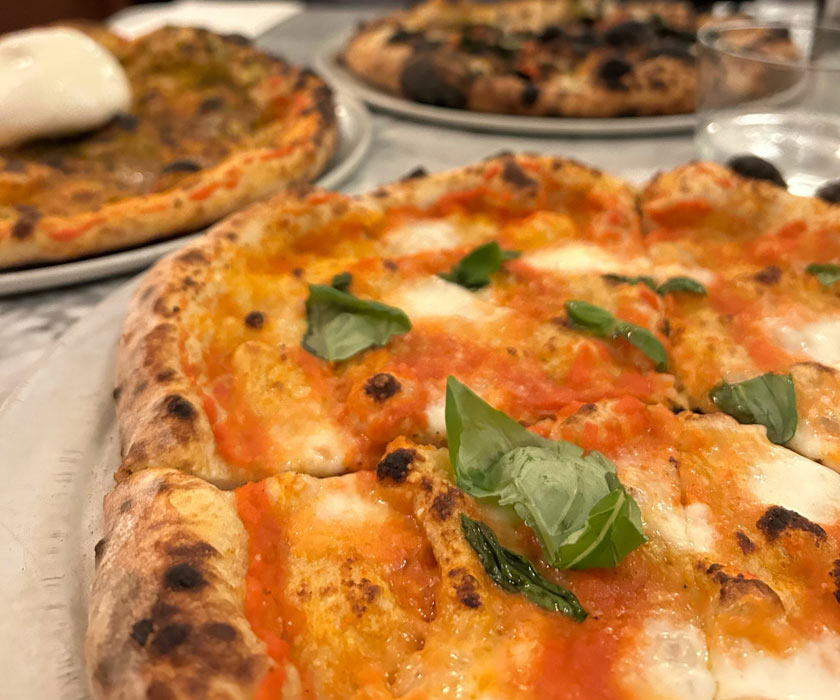
Graduate-level Ramen
Ramen, or instant Asian noodles, has long been associated with college students, lonely bachelors, SRO tenants, and clerical workers in windowless office lunchrooms. Today that is still the case, but folks can enjoy a much greater variety of noodles and flavors from throughout Asia. Many come with their own bowl, utensils, and multiple flavor packets: an oil/paste, dehydrated vegetables, and/or the traditional powder of MSG consummé.
To help me sample the more than 30 varieties I found, I recruited a tasting team that included Sarah Yanni, a personal chef from Healthy Home Cooking Services; and Ian Ludders, a sushi chef at Whole Foods Market.
Generally, instant noodles that come in their own bowl and with multiple flavor packs are better than the simpler varieties. But on the other hand, many of the exotic flavors, like kimchi, abalone, and “hot pork rib,” were disappointments. The preferences reflected herein are those of the reviewer, an admitted “low taster” (a condition marked by fewer taste buds per square inch and a preference for strong flavors).
Prisoners can use their meager wages to buy Ramen at the prison shop. Inmates cook “a batch” with whatever they can scrounge. The term can be used as a verb, as in: “I’m batching it tonight with chips and mustard.”
Fashion Food (FF), a company out of Thailand, makes Tom-Yum Seafood Creamy Flavor. It’s not particularly creamy, but very good nonetheless. It comes in a sturdy plastic bowl and cover. I wouldn’t necessarily recommend the packaging unless you’re planning a picnic, but the bowls do make a good hard-shell yarmulke.

Fashion Food also makes a Beef (Pho) Flavor that has the same distinct taste as Vietnamese restaurant Pho – just add you own raw, thin-sliced eye of round, beef navel and tendon. The plastic container has a snap-on lid with vent holes.
The Bulalo Flavor variety comes with dehydrated vegetables and TVP, a soup pack with the words “Lucky Me” printed on it, a packet of beef fat, and a packet of two FITA crackers (think Ritz). The flavor is distinct, almost earthy. Bulalo is the Filipino term for a cross-cut beef shank with marrow. This dish is cooked in a clear broth like a pot-au-feu. By contrast, Italian cross-cut shank bone, ossobuco(“bone hole”), is served braised.
Mama brand makes Thai hot-and-sour–style soups that have good noodle texture and are tasty enough to serve to company. If you can read eight-point type, look for lemon grass and kefir lime leaf in the ingredients. The bag-packaged version comes with wheat noodles; the bowl comes with rice noodles, five dried shrimp, and a folding fork.
Indomie brand, from Indonesia, makes Indian-style curry chicken and the Mi goreng flavor (below). Both are among the best-tasting and least expensive varieties I found. Indonesia is the largest Muslim country in the world, and Indomie’s products are halal, which means they are Kosher, sort of.
Tung Instant Rice Noodles’ Chinese onion flavor gets points for resembling its purported flavor, but mainly tastes of onion powder.
Among the varieties with whole rice grains, Mama’s Jok Cup is the best. This is a rice congee (porridge) with discernable pieces of seafood.
DIY’ers can make their own, MSG-free soup in about 10 minutes. Boil dried vegetables and noodles, then add sauces, condiments, soup base, and fresh or cooked meats and vegetables. The trick is to add the ingredients at the right pace so that items (particularly the noodles) don’t overcook. Let the pot return to a boil after adding ingredients. The steps are as follows…
Heat peanut oil in a sauce pan
Sautee onion/shallot/ginger/garlic
Add boiling water
Add, in the following order:
dried mushroom stems
dried mussels
crushed mushroom tops
dried shrimp
(If making soup, add condiments, e.g. soup stock, miso, bullion cubes [has MSG], Thai curry paste, soy sauce, fish sauce, coconut milk, etc.)
Add dried Chinese vegetables
Add Vietnamese pork loaf or Chinese sausage
Add noodles (made from rice, wheat, tapioca, millet, sweat potato or virtually any other starch)
Add frozen veggies
Add frozen, precooked shrimp
(If making noodles, drain liquid [makes a good soup base] and add select condiments from the list above.)
My tasters told me I would be remiss not to mention something called “Asian Cole Slaw” (cabbage with crushed ramen noodles), which is apparently all the rage in the potluck circles. My recipe was made with what I had on hand: dry noodles, Chinese cabbage, regular white cabbage, Thai hot peppers, mayonnaise (mayophobes can substitute peanut, sesame or olive oil), and fried garlic. The dressing – a mixture of equal parts miso paste and molasses, and three parts vinegar – is best when using high-quality miso and vinegar.
— Zachary Barowitz
















